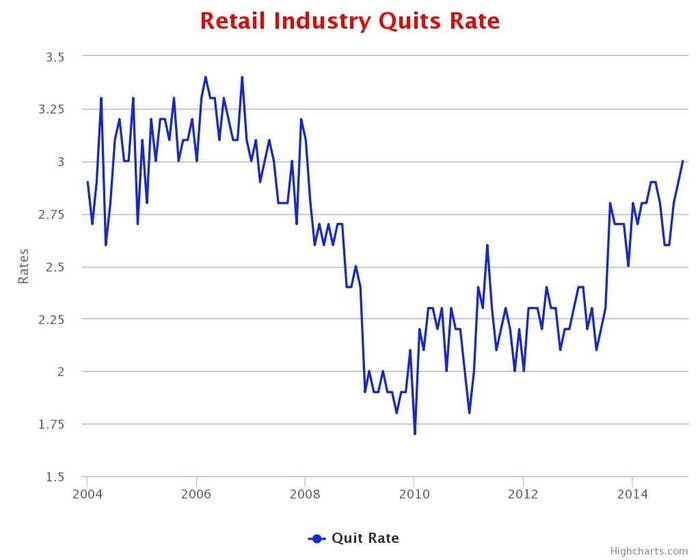
Here's one reason why big retailers have been making noise about raising their minimum wages: Their workers have been quitting at a rate last seen in the boom times before the financial crisis.
Wal-Mart, America's biggest private employer, made headlines last week for raising its minimum wage, becoming the latest in a string of companies upping the pay of their lowest-paid workers.
The decision, which followed similar announcements out of Gap and Ikea in recent months, underscores the fact that retail workers are getting harder to hold on to these days. The retail industry's "quits rate" — the number of people quitting from jobs in a month as a percent of total employment — has been climbing to levels last seen before the recession, according to the Bureau of Labor Statistics, which means companies may have to do more to keep employees happy.
The quits rate is seen as reflecting workers' willingness or ability to leave their jobs, which itself can be connected to the broader economic environment and the prospects of finding work elsewhere. After reaching highs during the heady economic times of 2006–07, it fell significantly during the recession and stayed low in the years of uncertainty that followed. It's now back to levels last seen in January 2008.
Wage increases at Wal-Mart and Gap, both to at least $10 an hour next year, are "in part due to escalating quit rates," Edward Yruma, an analyst at KeyBanc Capital Markets, wrote in a Feb. 22 note. "We believe that other retailers in our coverage could be compelled to raise hourly rates to the $10 an hour level," he said, pointing to teen retailers in particular.
To be sure, retail and fast-food industry workers have been fighting aggressively for a higher minimum wage in the past few years, and many employees don't have the option of leaving low-paying jobs.
But, as the economy improves, and the unemployment rate drops to 5.7%, workers may have more options. Offering higher pay, better benefits, and training opportunities is a good way to keep them and to avoid paying the costs tied to hiring and retraining.
"A pickup in the quit rate, which also remains at a low level, would signal that workers perceive that their chances to be rehired are good," Federal Reserve Chair Janet Yellen said in a March 2013 speech. "In other words, that labor demand has strengthened."

